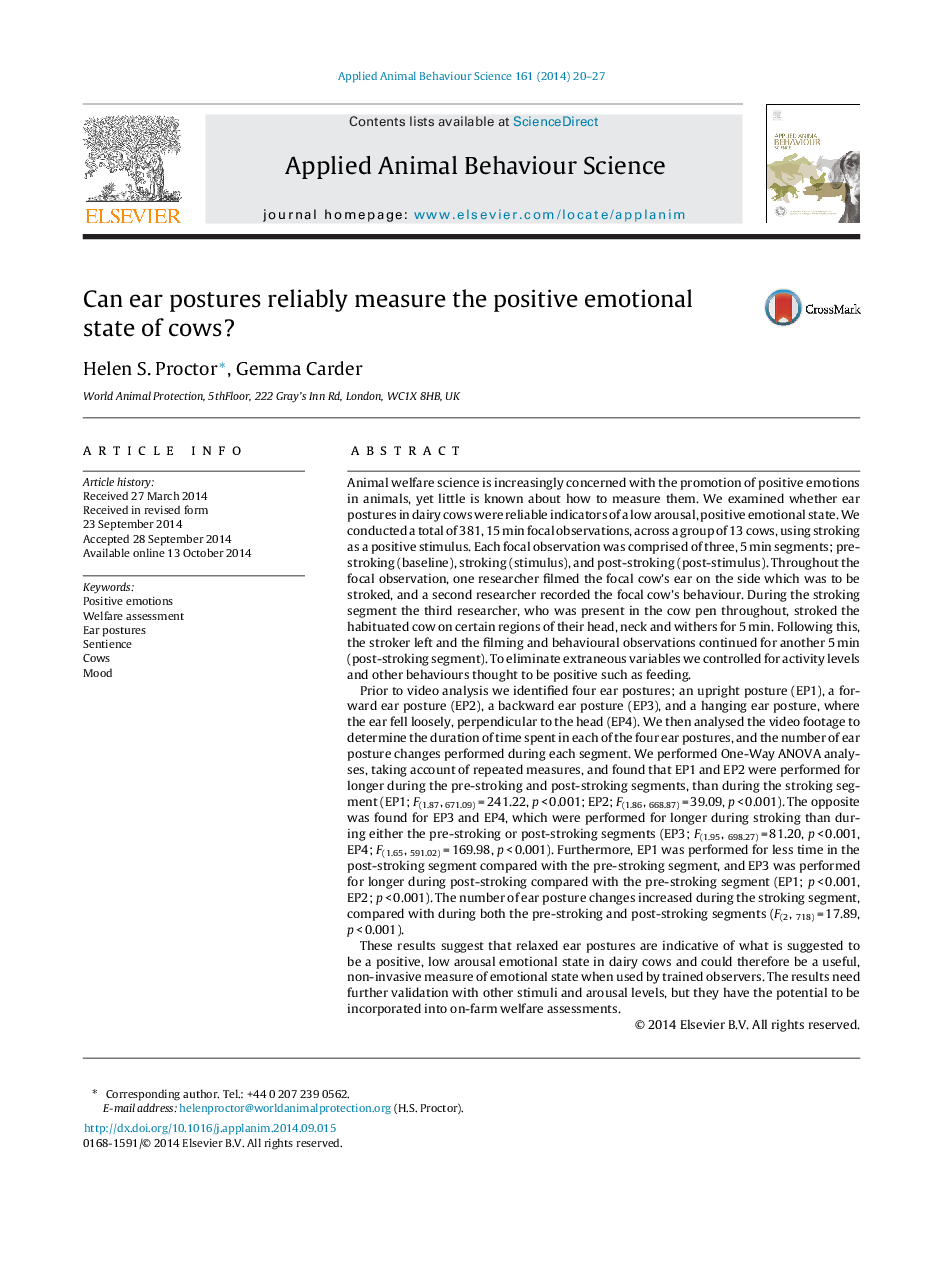| کد مقاله | کد نشریه | سال انتشار | مقاله انگلیسی | نسخه تمام متن |
|---|---|---|---|---|
| 4522509 | 1625345 | 2014 | 8 صفحه PDF | دانلود رایگان |
• Investigated whether ear postures indicate a positive emotional state in cows.
• The number of ear posture changes was also examined.
• Ear postures were found to indicate a low arousal positive emotional state.
• Measures of positive emotions are key to ensuring good animal welfare.
Animal welfare science is increasingly concerned with the promotion of positive emotions in animals, yet little is known about how to measure them. We examined whether ear postures in dairy cows were reliable indicators of a low arousal, positive emotional state. We conducted a total of 381, 15 min focal observations, across a group of 13 cows, using stroking as a positive stimulus. Each focal observation was comprised of three, 5 min segments; pre-stroking (baseline), stroking (stimulus), and post-stroking (post-stimulus). Throughout the focal observation, one researcher filmed the focal cow's ear on the side which was to be stroked, and a second researcher recorded the focal cow's behaviour. During the stroking segment the third researcher, who was present in the cow pen throughout, stroked the habituated cow on certain regions of their head, neck and withers for 5 min. Following this, the stroker left and the filming and behavioural observations continued for another 5 min (post-stroking segment). To eliminate extraneous variables we controlled for activity levels and other behaviours thought to be positive such as feeding.Prior to video analysis we identified four ear postures; an upright posture (EP1), a forward ear posture (EP2), a backward ear posture (EP3), and a hanging ear posture, where the ear fell loosely, perpendicular to the head (EP4). We then analysed the video footage to determine the duration of time spent in each of the four ear postures, and the number of ear posture changes performed during each segment. We performed One-Way ANOVA analyses, taking account of repeated measures, and found that EP1 and EP2 were performed for longer during the pre-stroking and post-stroking segments, than during the stroking segment (EP1; F(1.87, 671.09) = 241.22, p < 0.001; EP2; F(1.86, 668.87) = 39.09, p < 0.001). The opposite was found for EP3 and EP4, which were performed for longer during stroking than during either the pre-stroking or post-stroking segments (EP3; F(1.95, 698.27) = 81.20, p < 0.001, EP4; F(1.65, 591.02) = 169.98, p < 0.001). Furthermore, EP1 was performed for less time in the post-stroking segment compared with the pre-stroking segment, and EP3 was performed for longer during post-stroking compared with the pre-stroking segment (EP1; p < 0.001, EP2; p < 0.001). The number of ear posture changes increased during the stroking segment, compared with during both the pre-stroking and post-stroking segments (F(2, 718) = 17.89, p < 0.001).These results suggest that relaxed ear postures are indicative of what is suggested to be a positive, low arousal emotional state in dairy cows and could therefore be a useful, non-invasive measure of emotional state when used by trained observers. The results need further validation with other stimuli and arousal levels, but they have the potential to be incorporated into on-farm welfare assessments.
Journal: Applied Animal Behaviour Science - Volume 161, December 2014, Pages 20–27
